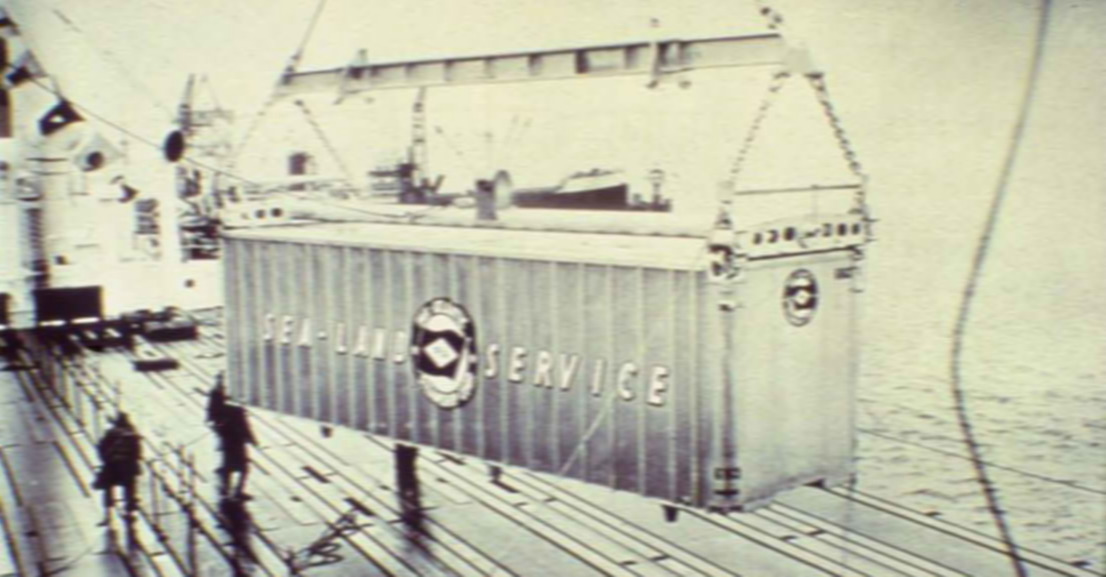
One day in 1937, a young truck driver named Malcolm McLean was sitting in his cab at the port of Hoboken, waiting for the stevedors (longshoremen) to unload his truckful of cotton from his home state of North Carolina. As he waited for what turned out to be the bulk of the day, he wondered at how he could improve the technology used to load and unload freight ships. After all, it had been around since the ancient Phoenicians began trading across the Mediterranean in approximately 1,500 BCE.
It took nearly two decades, but to be fair, he was busy building his trucking firm into the 5th largest in the country. Ultimately, the standardized shipping container McLean invented would come to dominate global shipping—revolutionizing port operations along the way.
His plans began to bear fruit when, in 1956, he purchased two decommissioned World War II-era tankers and retrofitted them to hold containers below and above decks. In April of that year, the SS Ideal X departed from the port of Newark bound for the port of Houston with 58 35-foot “trailer vans,” later renamed containers, and modern ocean freight was changed forever. What Malcolm had no way of knowing was that his invention would lay the foundation for the modern, AI-powered freight tech platforms that are once again changing the face of international shipping today.
What started with tally sheets, clipboards, and early mainframe computers has now jumped to fully integrated tech platforms that connect existing systems with a layer of intelligent automation—it all started with the shift from loose freight to containerized shipping.
Pre-modern tech years (1956-2010)
The immediate impact of that first containerized run from New Jersey to Texas was improved safety for longshoremen, decreased time in port for ships, and major cost savings for shippers. Before containers, unloading a ship took days; after, it could be done in hours. It used to cost nearly $6.00/ton to unload a ship; after containerization, it cost $0.16.
Two things happened in the ‘60s to hasten the adoption of containerized shipping. First was the standardization of containers thanks to the ISO 668 standard, which gave us the 20/40-foot containers we know today. The second was that the U.S. military quickly adopted the increased efficiency of containerized shipping for use in resupplying troops in Vietnam.
There are interesting parallels when you look at the impact of the invention of the standardized shipping container and the current state of AI in the shipping and freight industries. The move to containers ultimately led to the longest port strike in the history of the ILWU, 130 days through 1971, fueled by fears of massive job losses.
In recent years, the ILWU has taken a similar stance on the inclusion of AI and other forms of automation at the ports, with leadership saying that automation won’t lead to increased productivity, only that it will ruin lives and take jobs away from their members. The 2024 ILU strike centered on banning automation at ports completely.
The reality is that the West Coast ILWU’s 1960 agreement that embraced containerization led to wages increasing by $1.72/day more than the East Coast (where they were more resistant to change) by 1970 [source]. Opportunities abound today, as well. When implemented thoughtfully, automation can, and has been proven to, enhance productivity and improve overall port operations—exactly as containerization did in the last century, by creating more opportunities than it eliminates.
Early digital foundations
Emerging from such military logistics was Electronic Data Interchange (EDI), a technology that is still in wide use more than half a century later. Along with the development of mainframe computing, which allowed large corporations to begin digitizing their shipping and inventory records, this era saw the nascent field of logistics technology take root.
Siloed data remained siloed
As connected computing was still in development, these digitized records could only serve the companies doing the digitizing. Such legacy systems operated independently and were, until fairly recently, seen as “nice-to-have” rather than “foundational” business infrastructure. This meant that many hours were spent manually entering data into each system to bridge the gaps between disconnected platforms.
Machine Learning makes an appearance
It took until the 1990s-early 2000s for machine learning (ML) to make its first appearance in logistics tech in the form of basic route-optimizing algorithms, as early statistical methods were applied to transportation planning. UPS and airlines took the lead during this period, using the emerging technologies for more efficient route planning and rudimentary demand forecasting.
With the release of full-featured GPS accuracy by President Clinton in 2000, modern logistics technology was ready for prime time. With the release of logistics modules in established systems like SAP’s Enterprise Resource Planning (ERP) platform, the stage was set.
The era of integration challenges (2010-2020)
By the 2010s, enough historical shipping data had accrued, and technology had advanced far enough, that more advanced ML training was possible. Companies began to realize their growing data lakes contained untapped insights that could give them a competitive advantage. Predictive analytics and early examples of real-time data processing became technically feasible, though they were still expensive to implement.
The data silo problem
Platforms like Transportation Management Systems (TMS), Warehouse Management Systems (WMS), and ERPs proliferated during this era. Each system was optimized for specific functions, but was still unable to communicate with the other, leaving data silos everywhere. With valuable information trapped in department-specific platforms, duplicate data, delayed workflows, and increased chances for human error were common. Some manual integration attempts were made via the development of custom software that had largely limited success and was prohibitively expensive.
Legacy infrastructure challenges
Existing systems simply weren’t designed with integration in mind. There was also widespread cultural resistance in the form of departments within a company being hesitant to share “their” data across the organization. Many companies were reluctant to replace entire ecosystems when they still did most of what they needed—the lure of interconnected systems wasn’t yet strong enough to overcome these challenges.
The emergence of the integration imperative
With last-mile tracking technology permitting customers to have transparency into the status of their orders, it didn’t take long before logistics teams were demanding the same from the rest of the supply chain. Fragmented systems were beginning to cause glaring competitive disadvantages for many companies. The emergence of cloud computing and Application Programming Interfaces (APIs) during this time began to demonstrate what was possible for forward-looking logistics companies when it came to flexible integration.
API impact grows (2020-2023)
Starting around 2020, companies began implementing standardized interfaces for real-time data exchange, thanks to the maturation of API technologies. Inefficient manual processes were replaced by instant updates, and single platforms were now able to manage air, sea, rail, and road freight seamlessly from a unified, cross-modal dashboard.
Security and user experience maturation
Around this same time, the world of Identity and access management (IAM) was also maturing. Single sign-on (SSO) provided tighter security and role-based access enabled cross-departmental data silo elimination via comprehensive operational visibility. Mobile access features allowed field operations access to the same level of visibility as those in the office.
Freight aggregator APIs transform operations
Once APIs had developed far enough, aggregators could provide cross-modal and cross-lane rate comparisons, allowing real-time analysis of carrier options and pricing. This level of data integration allowed seamless switching between transport modes and led to further cost savings for shippers. Along with this, AI made headway into freight tech, enabling robust recommendation engines for route and carrier selection, as well as automated alerts and alternative routing suggestions for exception handling.
Platform ecosystem development
Third-party developers were beginning to create specialized logistics applications, and Integration-as-a-Service made an appearance, offering companies a selection of pre-built connections to major supply chain platforms. Vertically integrated platforms for specific industries appeared as well, boosting efficiency across the automotive, retail, and manufacturing supply chains. This era also saw data standardization reach parity, with common schemas enabling easier integration between existing systems.
The platform revolution (2023-present)
The last few years have seen a massive acceleration in the development of freight tech platforms, ushering in the era of the modern intelligent automation and integration platforms, and bringing together several key innovations.
Intelligent workflow automation
Machine learning has advanced to the point it can power document processing, ingesting complex logistics documents with minimal, if any, human interaction. From data extraction to customs documentation preparation, the workflows can now be automated end-to-end. While these systems can handle routine tasks, they can also flag the more nuanced or complicated decisions for human intervention, bringing the best of both worlds together in one platform.
Human-in-the-loop architecture
Those exception flagging systems allow strategic oversight with the technology augmenting, not replacing, human expertise. This is called human-in-the-loop (HITL) architecture, and it’s key to the success of platforms like Reform. Managers can focus on the complex decisions while automation handles the rote tasks. Rather than forcing workflow alterations, they allow for customization to adapt to existing user experience.
Cross-platform integration without replacement
Along with HITL, Reform’s focus is on enabling companies to automate their existing systems and processes without the need to replace expensive software solutions already in place. With Reform, you can tie your existing TMS, WMS, and ERP systems together and automate workflows in a matter of hours, not weeks or months as in the not-too-distant past.
Modern platforms like Reform represent the current generation of AI-native logistics automation, combining machine learning algorithms, workflow automation, and real-time data processing within a single interface. These systems provide advanced analytics dashboards while maintaining operational efficiency and integrate smoothly within existing infrastructure as business needs evolve—allowing companies to automate rote processes without replacing functional systems.
What’s next for freight tech?
Freight technology has had quite a journey since the mid-20th century, taking us from manual loading and unloading of cargo to today’s intelligent automation platforms. What comes next is anyone’s guess, but we have a few ideas:
Integrated ecosystems and autonomous operations
Self-optimizing logistics networks and supply chains will allow parcels and containers to self-determine optimal routing within fully interconnected networks. Real-time visibility will expand to encompass the end-to-end supply chain, and platforms will be able to coordinate with each other to enable connected containers to use data from these aggregated networks to further optimize routing.
The technology convergence will accelerate
The Internet of Things (IoT) and blockchain technology will continue to work their way into logistics alongside AI to create fully transparent, secure, and efficient supply chains. Autonomous customs processing will appear, where authorities will access import documents instantly via integrated platforms. And predictive maintenance will come into its own, with self-monitoring equipment at shipyards and warehouses able to submit maintenance requests proactively.
The “Logistics services as software” model will likely mature and start finding its way into this ecosystem. AI agents will coordinate with carriers, negotiate rates, and verify invoices without the need for human intervention. And lastly, dynamic pricing models will emerge where real-time rate adjustments based on available capacity, demand, and market conditions will all be settled automatically.
Evolution is an ongoing process, not a one-and-done event
From Malcolm McLean’s frustration at the inefficiency of dock operations a century ago to today’s AI-powered platforms, freight tech evolution has been a continuous journey of solving fundamental problems. The standardized container created the basis for systematic tracking and data collection. EDI established digital document exchange, and APIs enabled real-time integration. Now, platforms like Reform represent the culmination of decades of incremental innovation.
The lesson is this: technological transformation in logistics won’t happen overnight. Each era built on what came before, solving the new challenges created by the last round of innovation, while creating opportunities for the next generation of solutions to solve. Platforms like Reform exist today because McLean standardized the container, EDI digitized documentation, and APIs connected previously disjointed systems.
The evolution continues, and the next breakthrough is likely already taking shape in the challenges being solved today.
When you’re ready to see how modern freight forwarding technology can transform your operations, discover how Reform’s AI-native intelligent automation platform builds on decades of logistics innovation to enhance your existing tech stack without disruption or replacement.









